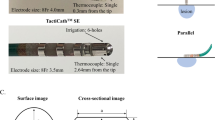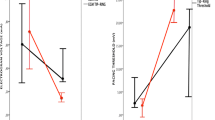Abstract
Research on technology for soft tissue radiofrequency (RF) ablation is ever advancing. A recent proposal to standardise terminology of RF electrodes only deals with the most frequently used commercial electrodes. The aim of this study was to develop a logical, versatile and unequivocal terminology to describe present and future RF electrodes and multiple electrode systems. We have carried out a PubMed search for the period from January 1 1990 to July 1 2004 in seven languages and contacted the six major companies that produce commercial RF electrodes for use in clinic. In a first step, names have been defined for the five existing basic designs of single-shaft electrode. These names had to be unequivocal, descriptive of the electrode’s main working principle and as short as possible. In a second step, these basic names have been used as building blocks to describe the single-shaft electrodes in combination designs. In a third step, using the same principles, a logical terminology has been developed for multiple electrode systems, defined as the combined use of more than one single-shaft RF electrode. Five basic electrode designs were identified and defined: plain, cooled, expandable, wet and bipolar electrodes. Combination designs included cooled–wet, expandable–wet, bipolar–wet, bipolar–cooled, bipolar–expandable and bipolar–cooled–wet electrodes. Multiple electrode systems could be characterised by describing several features: the number of electrodes that were used (dual, triple, ...), the electric mode (monopolar or bipolar), the activation mode (consecutive, simultaneous or switching), the site of the inserted electrodes (monofocal or multifocal), and the type of single shaft electrodes that were used. In this terminology, the naming of the basic electrode designs has been based on objective criteria. The short and unequivocal names of the basic designs can easily be combined to describe current and future combination electrodes. This terminology provides an exact and complete description of the versatile novel multiple electrode systems.








Similar content being viewed by others
References
Goldberg SN, Charboneau JW, Dodd GD III, Dupuy DE, Gervais DA, Gillams AR, Kane RA, Lee FT Jr, Livraghi T, McGahan JP, Rhim H, Silverman SG, Solbiati L, Vogl TJ, Wood BJ (2003) Image-guided tumor ablation: proposal for standardization of terms and reporting criteria. Radiology 228:335–345
http://www.radionics.com/default-ab.shtml. Accessed 4 Feb 2004
http://www.ritamedical.com/. Accessed 4 Feb 2004
http://www.bostonscientific.com/. Accessed 4 Feb 2004
http://www.berchtold.de/2/main2.htm. Accessed 4 Feb 2004
http://www.invatec.it/1024/index1024.htm. Accessed 4 Feb 2004
http://www.celon.com/htdocs/1tech/efset1.htm. Accessed 30 June 2004
Denys AL, De Baere T, Kuoch V, Dupas B, Chevallier P, Madoff DC, Schnyder P, Doenz F (2003) Radio-frequency tissue ablation of the liver: in vivo and ex vivo experiments with four different systems. Eur Radiol 13:2346–2352
Pereira PL, Trubenbach J, Schenk M, Subke J, Kroeber S, Schaefer I, Remy CT, Schmidt D, Brieger J, Claussen CD (2004) Radiofrequency ablation: in vivo comparison of four commercially available devices in pig livers. Radiology 232:482–490
De Baere T, Elias D, Ducreux M, Dromain C, Kuoch V, El Din MG, Sobotka A, Lasser P, Roche A (1999) Percutaneous radiofrequency ablation of hepatic metastases. Preliminary experience. Gastroenterol Clin Biol 23:1128–1133
Goldberg SN, Gazelle GS, Solbiati L, Rittman WJ, Mueller PR (1996) Radiofrequency tissue ablation: increased lesion diameter with a perfusion electrode. Acad Radiol 3:636–644
Lencioni R, Goletti O, Armillotta N, Paolicchi A, Moretti M, Cioni D, Donati F, Cicorelli A, Ricci S, Carrai M, Conte PF, Cavina E, Bartolozzi C (1998) Radio-frequency thermal ablation of liver metastases with a cooled-tip electrode needle: results of a pilot clinical trial. Eur Radiol 8:1205–1211
Lorentzen T (1996) A cooled needle electrode for radiofrequency tissue ablation: thermodynamic aspects of improved performance compared with conventional needle design. Acad Radiol 3:556–563
Solbiati L, Goldberg SN, Ierace T, Livraghi T, Meloni F, Dellanoce M, Sironi S, Gazelle GS (1997) Hepatic metastases: percutaneous radio-frequency ablation with cooled-tip electrodes. Radiology 205:367–373
Trübenbach J, Huppert PE, Pereira PL, Ruck P, Claussen CD (1997) Radiofrequency ablation of the liver in vitro: increasing the efficacy by perfusion probes. RoFo Fortschr Geb Rontgenstrahlen Neuen Bildgeb Verfahr 167:633–637
Goldberg SN, Solbiati L, Hahn PF, Cosman E, Conrad JE, Fogle R, Gazelle GS (1998) Large-volume tissue ablation with radio frequency by using a clustered, internally cooled electrode technique: laboratory and clinical experience in liver metastases. Radiology 209:371–379
Le Veen RF, Fox RL, Schneider PD, Hinrichs S (1996) Large volume porcine liver ablation with the use of a percutaneous expandable electrosurgical probe. J Vasc Interv Radiol 7(1, part 2):217–218
Mulier S, Ni Y, Miao Y, Rosiere A, Khoury A, Marchal G, Michel L (2003) Size and geometry of hepatic radiofrequency lesions. Eur J Surg Oncol 29:867–878
Hoey MF, Mulier PM, Shake JG (1995) Intramural ablation using radiofrequency energy via screw-tip catheter and saline electrode. PACE 18(II):917
Livraghi T, Goldberg SN, Monti F, Bizzini A, Lazzaroni S, Meloni F, Pellicano S, Solbiati L, Gazelle GS (1997). Saline-enhanced radio-frequency tissue ablation in the treatment of liver metastases. Radiology 202:205–210
Leveillee RJ, Hoey MF (2003) Radiofrequency interstitial tissue ablation: wet electrode. J Endourol 17:563–577
Mack M, Straub R, Desinger K, Balzer JO, Zangos S, Vogl TJ (2000) MR guided interstitial bipolar RF thermometry (RFITT): in vitro evaluations and first clinical results. Radiology 217(Suppl):539
Mack MG, Desinger K, Straub R, Stein T, Balzer JO, Vogl TJ (2002) MR-guided bipolar RF-thermotherapy (RFITT): in-vitro evaluations and first clinical results. Eur Radiol 12(Suppl 1):141
Ni Y, Miao Y, Marchal G (2003) Cooled-wet electrode. US Patent 6,514,251 B1, 4 Feb 2003. Priority date: August 14, 1998
Miao Y, Ni Y, Yu J, Marchal G (2000) A comparative study on validation of a novel cooled–wet electrode for radiofrequency ablation. Invest Radiol 35:438–444
Miao Y, Ni Y, Yu J, Marchal GJ (1999) Optimization of radiofrequency ablation by using an “expandable–wet” electrode: results of ex vivo experiment. Radiology 213:102
Miao Y, Ni Y, Yu J, Zhang H, Baert A, Marchal G (2001) An ex vivo study on radiofrequency tissue ablation: increased lesion size by using an “expandable–wet” electrode. Eur Radiol 11:1841–1847
Mulier P, Hoey M. Method and apparatus for creating a bi-polar virtual electrode used for the ablation of tissue. US Patent no 6238393 B1, May 29, 2001. Priority date July 6, 1999
Haemmerich D, Tungjitkusolmun S, Staelin ST, Lee FT Jr, Mahvi DM, Webster JG (2002) Finite-element analysis of hepatic multiple probe radio-frequency ablation. IEEE Trans Biomed Eng 49:836–842
Lee JM, Han JK, Kim SH, Lee JY, Kim DJ, Lee MW, Cho GG, Han CJ, Choi BI (2004) Saline-enhanced hepatic radiofrequency ablation using a perfused-cooled electrode: comparison of dual probe bipolar mode with monopolar and single probe bipolar modes. Korean J Radiol 5:121–127
Wright AS, Haemmerich DG, Chachati L, Webster JG, Mahvi DM, Lee FT (2002) Hepatic radiofrequency ablation with multiple active electrodes is superior to conventional overlapping technique in an ex vivo model. Radiology 225(Suppl):639
Goldberg SN, Gazelle GS, Dawson SL, Rittman WJ, Mueller PR, Rosenthal DI (1994) Radiofrequency tissue ablation using multiprobe arrays: greater tissue destruction than multiple probes operating alone. Radiology 193:S281
Gillams AR, Lees WR (2001) Optimisation of treatment strategy using cooled-tip radiofrequency electrodes in ex-vivo liver. Eur Radiol 11(Suppl A):171
Lee JM, Rhim H, Han JK, Youn BJ, Kim SH, Choi BI (2004) Dual-probe radiofrequency ablation: an in vitro experimental study in bovine liver. Invest Radiol 39:89–96
Shirato K, Morimoto M, Tomita N, Kokawa A, Sugimori K, Saito T, Tanaka K (2002) Hepatocellular carcinoma: percutaneous radiofrequency ablation using expandable needle electrodes and the double-insertion technique. Hepato-gastroenterology 49:1481–1483
Jones CD, McGahan JP, Gu W, Brock JM (1995) Percutaneous liver ablation using bipolar radiofrequency electrocautery. Radiology 197:140
Mulier S, Ni Y, Mulier P, Marchal G, Michel L (2003) Multi-bipolar electrode system. Patent application GB0318661A0, 8 Aug 2003
Mulier S, Ni Y, Mulier P, Marchal G, Michel L (2003) Linear radiofrequency coagulation. Patent application GB0324458A0, 21 Oct 2003
Burdio F, Guemes A, Burdio JM, Castiella T, De Gregorio MA, Lozano R, Livraghi T (1999) Hepatic lesion ablation with bipolar saline-enhanced radiofrequency in the audible spectrum. Acad Radiol 6:680–686
Burdio F, Guemes A, Burdio JM, Navarro A, Sousa R, Castiella T, Cruz I, Burzaco O, Lozano R (2003) Bipolar saline-enhanced electrode for radiofrequency ablation: results of experimental study of in vivo porcine liver. Radiology 229:447–456
Lee FT, Staelin ST, Haemmerich D, Tungjitkusolmun S, Johnson CD, Mahvi DM (2000) Bipolar RF produces larger zones of necrosis than conventional monopolar RF in pig livers. Radiology 217(Suppl):229
Gananadha S, Morris DL (2004) Novel in-line multielectrode radiofrequency ablation considerably reduces blood loss during liver resection in an animal model. ANZ J Surg 74:482–485
Lee FT, Haemmerich D, Wright AW, Mahvi DM, Sampson LA, Webster JG (2003) Multiple probe radiofrequency ablation: pilot study in an animal model. J Vasc Interv Radiol 14:1437–1442
Lee JM, Han JK, Kim SH, Sohn KL, Choi SH, Choi BI (2004) Bipolar radiofrequency ablation in ex vivo bovine liver with the open–perfused system versus the cooled–wet system. Eur Radiol 2004 Jul 10 [Epub ahead of print]
Xu H, Xie X, Lu M, Chen J, Yin X, Xu Z, Liu G (2004) Ultrasound-guided percutaneous thermal ablation of hepatocellular carcinoma using microwave and radiofrequency ablation. Clin Radiol 59:53–61
Solbiati L, Ierace T, Goldberg SN, Sironi S, Livraghi T, Fiocca R, Servadio G, Rizzatto G, Mueller PR, Del Maschio A, Gazelle GS (1997) Percutaneous US guided radiofrequency tissue ablation of liver metastases: treatment and follow up in 16 patients. Radiology 202:195–203
Lobo SM, Afzal KS, Ahmed M, Kruskal JB, Lenkinski RE, Goldberg SN (2004) Radiofrequency ablation: modeling the enhanced temperature response to adjuvant NaCl pretreatment. Radiology 230:175–182
Lubienski A, Wirth-Jaworski L, Hahn T, Bitsch R, Lubienski K, Dechow C, Kauffmann G, Düx M (2003) Tissue modulation during radiofrequency ablation in an experimental liver perfusion model. Eur Radiol 13(Suppl 2):S114
Kim YK, Lee JM, Kim SW, Kim CS (2003) Combined radiofrequency ablation and hot saline injection in rabbit liver. Invest Radiol 38:725–732
Lee JM, Kim YK, Lee YH, Kim SW, Li CA, Kim CS (2003) Percutaneous radiofrequency thermal ablation with hypertonic saline injection: in vivo study in a rabbit liver model. Korean J Radiol 4:27–34
Solbiati L, Goldberg SN, Livraghi T, Meloni F, Ierace T, Cova L (2000) Radiofrequency thermal ablation: increased treatment effect with saline pre-treatment. Radiology 217(Suppl):607
Helton WS (2004) Minimizing complications with radiofrequency ablation for liver cancer: the importance of properly controlled clinical trials and standardized reporting. Ann Surg 239:459–463
Buscarini E, Buscarini L (2004) Radiofrequency thermal ablation with expandable needle of focal liver malignancies: complication report. Eur Radiol 14:31–37
Omary RA, Bettmann MA, Cardella JF, Bakal CW, Schwartzberg MS, Sacks D, Rholl KS, Meranze SG, Lewis CA; Society of Interventional Radiology Standards of Practice Committee (2003) Quality improvement guidelines for the reporting and archiving of interventional radiology procedures. J Vasc Interv Radiol 14(9 Pt 2):S293–S295
Kettenbach J, Blum M, Kilanowicz E, Schwaighofer SM, Lammer J (2004) Percutaneous radiofrequency-ablation of liver cell carcinoma: a current overview. Radiologe 44:330–338
Schmidt D, Trubenbach J, Konig CW, Brieger J, Duda S, Claussen CD, Pereira PL (2003) Radiofrequenzablation ex-vivo: Vergleich der Effektivität von impedance control mode versus manual control mode unter Verwendung einer geschlossen perfundierten Cluster-Ablationssonde. RoFo Fortschr Geb Rontgenstrahlen Neuen Bildgeb Verfahr 175:967–972
Ni Y, Miao Y, Mulier S, Yu J, Baert AL, Marchal G (2000) A novel ‘cooled–wet’ electrode for radiofrequency ablation. Eur Radiol 10:852–854
Miao Y, Ni Y, Mulier S, Yu J, De Wever I, Penninckx F, Baert AL, Marchal G (2000) Treatment of VX2 liver tumor in rabbits with “wet” electrode mediated radio-frequency ablation. Eur Radiol 10:188–194
Hänsler J, Witte A, Strobel D, Wein A, Bernatik T, Pavel M, Muller W, Hahn EG, Becker D (2003) Radio-frequency-ablation (RFA) with wet electrodes in the treatment of primary and secondary liver tumours. Ultraschall Med 24:27–33
Gangi A, Guth S, Imbert J (2003) Interest of radiofrequency liver tissue ablation with a bipolar–wet electrode. Eur Radiol 13(Suppl 1):477
Acknowledgements
The authors wish to thank Marie-Bernadette Jacqmain for the illustrations and Christian Deneffe for layout.
Author information
Authors and Affiliations
Corresponding author
Rights and permissions
About this article
Cite this article
Mulier, S., Miao, Y., Mulier, P. et al. Electrodes and multiple electrode systems for radiofrequency ablation: a proposal for updated terminology. Eur Radiol 15, 798–808 (2005). https://doi.org/10.1007/s00330-004-2584-x
Received:
Accepted:
Published:
Issue Date:
DOI: https://doi.org/10.1007/s00330-004-2584-x




